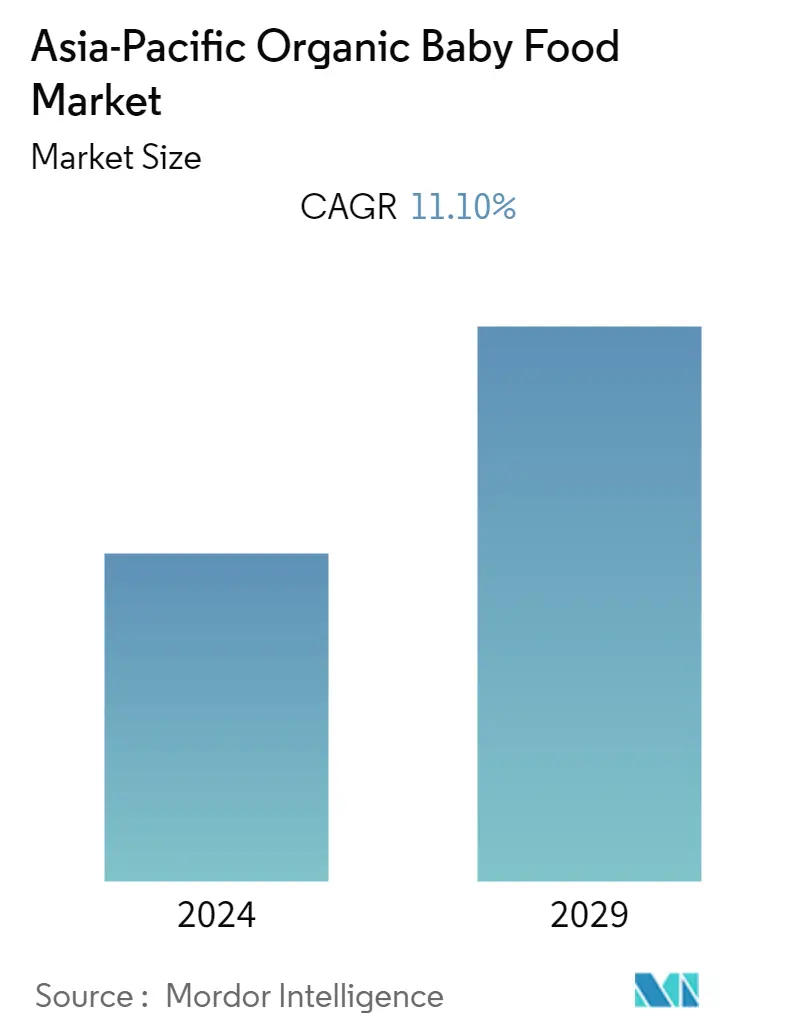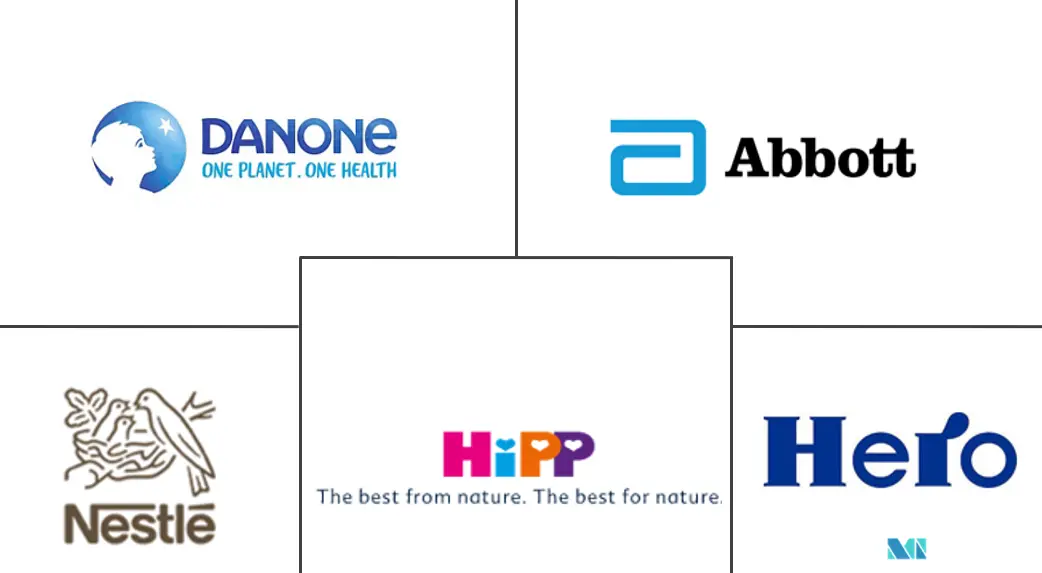Market Size of Asia-Pacific Organic Baby Food Industry

| Study Period | 2019 - 2029 |
| Base Year For Estimation | 2023 |
| Forecast Data Period | 2024 - 2029 |
| Historical Data Period | 2019 - 2022 |
| CAGR | 11.10 % |
| Market Concentration | Low |
Major Players
*Disclaimer: Major Players sorted in no particular order |
APAC Organic Baby Food Market Analysis
The Asia-Pacific organic baby food market is projected to register a CAGR of 11.1% during the forecast period.
The growing awareness of the harmful effects of synthetic ingredients present in baby foods and the authenticity associated with organic baby food is driving consumers to switch to organic baby food as it is free of chemicals. The increased concern about the prevalence of lifestyle diseases is a major factor contributing to the growth of organic baby foods.
Over the long term, the baby food market is estimated to expand as parents seek healthy and nutritious ready-to-eat food options for their babies. The availability of a diverse product range for various flavors and innovations in baby food is estimated to drive the Asia-Pacific organic baby food market. Moreover, manufacturers are producing snacks that are suitable for infants at the teathing stage and introducing food textures and tastes, which is boosting the growth of the market.
Organic baby foods are considered premium products in the region. The high price of organic baby foods due to the high cost of organic raw materials is restraining the growth of the market in the region, as only high-income groups can afford organic baby foods. However, the willingness of parents to pay for healthy food is increasing the sales of organic baby foods.
APAC Organic Baby Food Industry Segmentation
Organic baby food is baby food processed using ingredients that are grown without the use of synthetic fertilizers or pesticides. The organic baby food market is segmented by product type, distribution channel, and geography. By product type, the segmentation includes prepared baby food, dried baby food, milk formula, and other product types. By distribution channel, the market is segmented into supermarkets/hypermarkets, convenience stores, online retail stores, and other distribution channels. By geography, the market is segmented into China, India, Japan, Australia, and the Rest of Asia-Pacific. For each segment, the market sizing and forecasts are done in value (USD million).
| By Product Type | |
| Milk Formula | |
| Prepared Baby Food | |
| Dried Baby Food | |
| Other Product Types |
| By Distribution Channel | |
| Supermarkets/Hypermarkets | |
| Convenience Stores | |
| Online | |
| Other Distribution Channels |
| By Geography | |
| China | |
| Japan | |
| India | |
| Australia | |
| Rest of Asia-Pacific |
Asia-Pacific Organic Baby Food Market Size Summary
The Asia-Pacific organic baby food market is experiencing significant growth, driven by increasing consumer awareness of the adverse effects of synthetic ingredients and a preference for chemical-free options. This shift is largely due to concerns over lifestyle diseases and the desire for healthier, nutritious ready-to-eat food for infants. The market is further bolstered by a diverse range of product offerings, including innovative snacks for teething infants and new food textures and tastes. Despite the premium pricing of organic baby foods, which limits accessibility to higher-income groups, there is a growing willingness among parents to invest in healthier food choices for their children. The demand for organic products is also fueled by concerns over pesticide and chemical residues, prompting a preference for clean-label products.
China holds a prominent position in the Asia-Pacific organic baby food market, with factors such as a rising population, increasing number of working women, and a focus on immunity-boosting ingredients driving sales. The market is highly competitive, with major players like Abbott Laboratories, Nestle SA, The Hein Celestial Group, and Danone SA actively engaging in product innovations, strategic partnerships, and expansions to enhance their market presence. These companies are also focusing on sustainability, as evidenced by Nestle SA's launch of carbon-neutral toddler formula. The market's growth is supported by the introduction of new products and packaging innovations, such as HiPP's customized infant formula packaging, which aims to reduce contamination risks.
Asia-Pacific Organic Baby Food Market Size - Table of Contents
-
1. MARKET DYNAMICS
-
1.1 Market Drivers
-
1.2 Market Restraints
-
1.3 Porter's Five Forces Analysis
-
1.3.1 Threat of New Entrants
-
1.3.2 Bargaining Power of Buyers/Consumers
-
1.3.3 Bargaining Power of Suppliers
-
1.3.4 Threat of Substitute Products
-
1.3.5 Intensity of Competitive Rivalry
-
-
-
2. MARKET SEGMENTATION
-
2.1 By Product Type
-
2.1.1 Milk Formula
-
2.1.2 Prepared Baby Food
-
2.1.3 Dried Baby Food
-
2.1.4 Other Product Types
-
-
2.2 By Distribution Channel
-
2.2.1 Supermarkets/Hypermarkets
-
2.2.2 Convenience Stores
-
2.2.3 Online
-
2.2.4 Other Distribution Channels
-
-
2.3 By Geography
-
2.3.1 China
-
2.3.2 Japan
-
2.3.3 India
-
2.3.4 Australia
-
2.3.5 Rest of Asia-Pacific
-
-
Asia-Pacific Organic Baby Food Market Size FAQs
What is the current Asia-Pacific Organic Baby Food Market size?
The Asia-Pacific Organic Baby Food Market is projected to register a CAGR of 11.10% during the forecast period (2024-2029)
Who are the key players in Asia-Pacific Organic Baby Food Market?
Nestle SA, Hero Group, Abbott Laboratories, Danone SA and Hipp Gmbh & Co. are the major companies operating in the Asia-Pacific Organic Baby Food Market.

